
Veracruz, formally Veracruz de Ignacio de la Llave, officially the Free and Sovereign State of Veracruz de Ignacio de la Llave, is one of the 31 states which, along with Mexico City, comprise the 32 Federal Entities of Mexico. Located in eastern Mexico, Veracruz is bordered by seven states, which are Tamaulipas, San Luis Potosí, Hidalgo, Puebla, Oaxaca, Chiapas, and Tabasco. Veracruz is divided into 212 municipalities, and its capital city is Xalapa-Enríquez.

The Totonac are an indigenous people of Mexico who reside in the states of Veracruz, Puebla, and Hidalgo. They are one of the possible builders of the pre-Columbian city of El Tajín, and further maintained quarters in Teotihuacán. Until the mid-19th century they were the world's main producers of vanilla.

Papantla is a city and municipality located in the north of the Mexican state of Veracruz, in the Sierra Papanteca range and on the Gulf of Mexico. The city was founded in the 13th century by the Totonacs and has dominated the Totonacapan region of the state since then. The region is famed for vanilla, which occurs naturally in this region, the Danza de los Voladores and the El Tajín archeological site, which was named a World Heritage Site. Papantla still has strong communities of Totonacs who maintain the culture and language. The city contains a number of large scale murals and sculptures done by native artist Teodoro Cano García, which honor the Totonac culture. The name Papantla is from Nahuatl and most often interpreted to mean "place of the papanes". This meaning is reflected in the municipality's coat of arms.
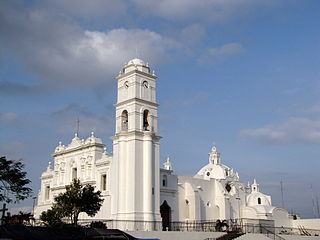
Misantla is a city in the Mexican state of Veracruz, the administrative seat of the municipality (municipio) of the same name. The municipality is bordered by Martínez de la Torre, Colipa and Papantla.

Cempoala or Zempoala is an important Mesoamerican archaeological site located in the Úrsulo Galván Municipality, in the state of Veracruz, Mexico. The site was inhabited mainly by Totonacs, Chinantecas and Zapotecs. It was one of the most important Totonac settlements during the postclassical Mesoamerican period and the capital of the kingdom of Totonacapan. It is located one kilometer from the shore of the Actopan River and six kilometres from the coast.

Totonacapan refers to the historical extension where the Totonac people of Mexico dominated, as well as to a region in the modern states of Veracruz and Puebla. The historical territory was much larger than the currently named region, extending from the Cazones River in the north to the Papaloapan River in the south and then west from the Gulf of Mexico into what is now the Sierra Norte de Puebla region and into parts of Hidalgo. When the Spanish arrived, the Totonac ethnicity dominated this large region, although they themselves were dominated by the Aztec Empire. For this reason, they allied with Hernán Cortés against Tenochtitlán. However, over the colonial period, the Totonac population and territory shrank, especially after 1750 when mestizos began infiltrating Totonacapan, taking political and economic power. This continued into the 19th and 20th centuries, prompting the division of most of historical Totonacpan between the states of Puebla and Veracruz. Today, the term refers only to a region in the north of Veracruz where Totonac culture is still important. This region is home to the El Tajín and Cempoala archeological sites as well as Papantla, which is noted for its performance of the Danza de los Voladores.
The Totonacan languages are a family of closely related languages spoken by approximately 290,000 Totonac and Tepehua people in the states of Veracruz, Puebla, and Hidalgo in Mexico. At the time of the Spanish conquest Totonacan languages were spoken all along the gulf coast of Mexico. During the colonial period, Totonacan languages were occasionally written and at least one grammar was produced. In the 20th century the number of speakers of most varieties have dwindled as indigenous identity increasingly became stigmatized encouraging speakers to adopt Spanish as their main language.
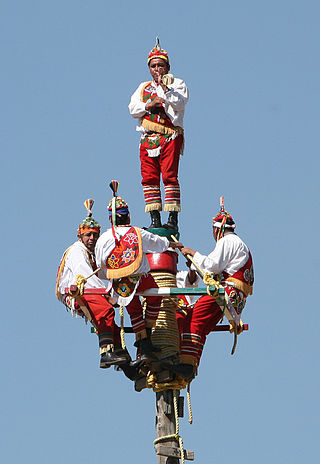
The Danza de los Voladores, or Palo Volador, is an ancient Mesoamerican ceremony/ritual still performed today, albeit in modified form, in isolated pockets in Mexico. It is believed to have originated with the Nahua, Huastec and Otomi peoples in central Mexico, and then spread throughout most of Mesoamerica. The ritual consists of dance and the climbing of a 30-meter pole from which four of the five participants then launch themselves tied with ropes to descend to the ground. The fifth remains on top of the pole, dancing and playing a flute and drum. According to one myth, the ritual was created to ask the gods to end a severe drought. Although the ritual did not originate with the Totonac people, today it is strongly associated with them, especially those in and around Papantla in the Mexican state of Veracruz. The ceremony was named an Intangible cultural heritage by UNESCO in order to help the ritual survive and thrive in the modern world. The Aztecs believed that Danza de los Voladores was the symbol of their culture.
Sierra Totonac is a native American language complex spoken in Puebla and Veracruz, Mexico. One of the Totonacan languages, it is also known as Highland Totonac. The language is best known through the work of the late Herman “Pedro” Aschmann who produced a small dictionary and several academic articles on the language.
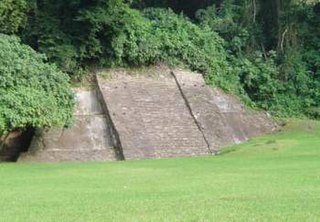
Cuyuxquihui is an archaeological site located in the Tecolutla valley of Veracruz, Mexico, in the region of the Totonac culture, about 22 kilometres (14 mi) southeast of El Tajín or 5 kilometres (3.1 mi) southeast of Paso de Correo.

The Sierra Norte de Puebla is a rugged mountainous region accounting for the northern third of the state of Puebla, Mexico. It is at the intersection of the Trans-Mexican Volcanic Belt and the Sierra Madre Oriental, between the Mexican Plateau and the Gulf of Mexico coast. From the Mesoamerican period to the 19th century, this area was part of a larger region called Totonacapan, and area dominated by the Totonac people, extending further east to the Gulf of Mexico. Political maneuvers to weaken the Totonacs led to the region being divided between the modern states of Puebla and Veracruz with the Puebla section given its current name. Until the 19th century, the area was almost exclusively indigenous, with the four main groups still found here today, Totonacs, Nahuas, Otomis and Tepehuas, but coffee cultivation brought in mestizos and some European immigrants who took over political and economic power. While highly marginalized socioeconomically, the area has been developed heavily since the mid 20th century, especially with the building of roadways linking it to the Mexico City area and the Gulf coast.

El Zapotal is a Totonac archaeological site located in the Ignacio de la Llave Municipality in Veracruz, Mexico. It contains the ruins of a Totonac city that flourished from 600 to 900 CE, during what archaeologists call the Classical Period.
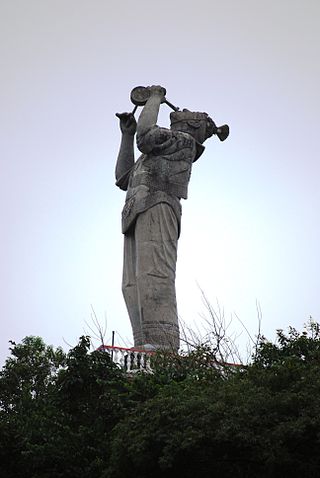
Teodoro Cano Garcia is an artist from Papantla, Veracruz, Mexico who is best known for his mural work depicting the Totonac culture of his native region in northern Veracruz. Cano was discovered by Diego Rivera, who helped Cano as a youth enter the prestigious San Carlos Academy and then employed him as an assistant with the mural work being done at the Ciudad Universitaria in Mexico City. Cano painted his first solo mural in 1953, and since then has produced paintings, murals, sculptures, photography, book illustrations and more, including creating a high relief technique with a cement base. However, Cano is best known for his mural work which depicts and promotes the Totonac culture, and much of his work can be seen in his hometown, including a monumental sculpture of a Volador dancer overlooking the city. Cano also worked as an academic for over 36 years, recently retiring, but he continues to work as an artist based in Xalapa.

Huatusco is an archaeological site located in the Carrillo Puerto municipality, near the small, almost deserted town of Santiago Huatusco, on the northern bank of the Rio Atoyac in the Rancho El Fortin. The importance of the site due to the nearly undamaged pyramid from prehispanic times, the largest part of the actual temple is still standing, in the state of Veracruz, Mexico.
Mesa de Cacahuatenco is a Mesoamerican pre-Columbian archeological site, located in the municipality of Ixhuatlán de Madero in northern Veracruz, Mexico, south of the Vinasca River.

Las Choapas is a recently found archaeological site located within the municipality of Las Choapas, in the southeastern border of the Veracruz State, inside the San Miguel de Allende Ejido, bordering the municipalities of Huimanguillo, Tabasco and Ostuacán, in Chiapas.

Susan Smythe Kung is the Manager of the Archive of the Indigenous Languages of Latin America at the LLILAS Benson Latin American Studies and Collections at the University of Texas at Austin. Kung is a linguist who specializes in endangered language archiving and the Huehuetla Tepehua language of Hidalgo, Mexico. She earned her doctorate in linguistics in 2007 from the University of Texas at Austin, and her dissertation, A Descriptive Grammar of Huehuetla Tepehua won the Mary R. Haas Book Award from the Society for the Study of the Indigenous Languages of the Americas. Kung is the President of DELAMAN, the Digital Endangered Languages and Music Archiving Network from 2016-2018 and is a founding member of the Linguistics Data Interest Group (LDIG) of the Research Data Alliance.
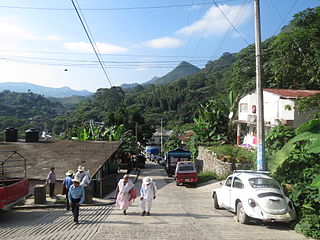
Huehuetla is a rural municipality in Puebla, Mexico.

Juan de Escalante was a Spanish military man. He joined as a captain on Hernán Cortés' expedition and in 1519 he was commander of the garrison of Veracruz.


















